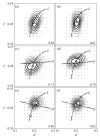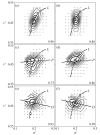Anomalous trichromats' judgments of surface color in natural scenes under different daylights
- PMID: 16962006
- PMCID: PMC1866190
- DOI: 10.1017/S0952523806233297
Anomalous trichromats' judgments of surface color in natural scenes under different daylights
Abstract
Deuteranomalous trichromacy, which affects medium-wavelength-sensitive cones, is more common than protanomalous trichromacy, which affects long-wavelength-sensitive cones. The aim of the present work was to test the extent to which these two kinds of anomalous trichromacy affect surface-color judgments in the natural world. Simulations of 18 natural scenes under different daylight illuminants were presented on a high-resolution color monitor to 7 deuteranomalous, 7 protanomalous, and 12 normal trichromatic observers, who had to discriminate between reflectance and illuminant changes in the images. Observers' ability to judge surface color was quantified by a standard color-constancy index. Deuteranomalous trichromats performed as well as normal trichromats, but protanomalous trichromats performed more poorly than both. The results are considered in relation to the spectral coverage of cones, rod intrusion, and the characterization of anomalous trichromacy by the Rayleigh match.
Figures



 and first illuminant 4000 K
and first illuminant 4000 K  , and for deuteranomalous trichromats with first illuminant 25000 K
, and for deuteranomalous trichromats with first illuminant 25000 K  and first illuminant 4000 K
and first illuminant 4000 K  .The dotted line is a linear regression, with slope equal to 0.065 and SE of 0.022.
.The dotted line is a linear regression, with slope equal to 0.065 and SE of 0.022.References
-
- Amano K, Foster DH, Nascimento SMC. Red-green colour deficiency and colour constancy under orthogonal-daylight changes. In: Mollon JD, Pokorny J, Knoblauch K, editors. Normal and defective colour vision. Oxford: Oxford University Press; 2003. pp. 225–230.
-
- Arend LE, Jr., Reeves A, Schirillo J, Goldstein R. Simultaneous color constancy: papers with diverse Munsell values. Journal of the Optical Society of America A-Optics Image Science and Vision. 1991;8:661–672. - PubMed
-
- Birch J. Diagnosis of Defective Colour Vision. London: Butterworth-Heinemann; 2001.
Publication types
MeSH terms
Grants and funding
LinkOut - more resources
Full Text Sources
Medical

